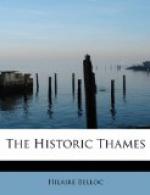Canute at Oxford, 55.
Carew obtains Chertsey, 164.
Charterhouse, Sheen, 108.
Chateau Gaillard compared to Windsor, 69.
Chaucer’s son custodian of Wallingford, 60.
Chertsey,
foundation of, 96;
Abbey, sack of, 137;
fate of land of, 159-165.
Cholsey, Priory of, 109, 166.
Churn joins Thames at Cricklade, 39.
Civil War,
destruction of Wallingford Castle under,
66;
of King and Parliament, 86-89.
Cluny, 102, 103.
Cobham, Manor of, twenty acres possessed by Chertsey in, 149.
Commons, Dissolution House of, significant names in, 146, 147.
Conquest, Norman,
See of Dorchester removed to Lincoln,
52, 102.
Constantine, legend of, at Abingdon, 98.
Conversion of Britain, position of Dorchester in, 49.
Cookham, early importance of, 191-194.
Cricklade,
importance of, 38-41;
small Priory of, 107;
ford at, 22.
“Cromwell,” Oliver. See Williams,
his destruction of Wallingford
Castle, 61.
Cromwell, or Smith of Putney, family of, 153-161.
Crown,
loses its manors, 144;
British, might have led the modern period
in Europe, 145-146;
cause of ruin of, weakness of Tudor character,
148.
Culham, attempted fortification of bridge of, 87.
Cumnor granted to Thomas Rowland, 139.
Currency, 134.
Cynegil, baptism of, at Dorchester, 50, 51.
Danes at Oxford, 54, 55.
Danish invasions destroy Chertsey, 97.
Davis obtains Pangbourne, 167.
Diocletian, his boundaries, 33;
legend of, at Abingdon, 98.
Dissolution and destruction of monasteries, 110-152.
Domesday Survey,
Oxford in, 56-58;
Survey, ambiguity of, 57;
indecision of, 176, 177.
Dorchester, 33, 47-52, 107, 108.
Dover, isolated defence of, 75.
Drainage of swamps, monastic work in, 97, 98.
Dudley obtains Pangbourne, 167.
Durham, appearance of, before the Dissolution, compared
to Reading,
114.
Duxford, ford at, 22.
Ealing, tidal river passable at, 24.
Eaton, meaning of place name, 31.
Economic aspect of Dissolution, 115-137;
aspect of monastic system, 116-118;
of the rise of gentry, 143, 144.
Edge Hill, battle of, 88.
Edmund Ironside at Oxford, 55.
Edward the Confessor,
manorial lord of Old Windsor, 70;
the Confessor rebuilds Westminster Abbey,
96.
Edward I.,
prisoner in youth at Wallingford, 60;
his march when a prince to the Tower from
Windsor, 85.
Edward II. leaves the Tower, 85.
Edwardes obtains Cholsey, 166.
Elizabeth restores purity of currency, 134.




